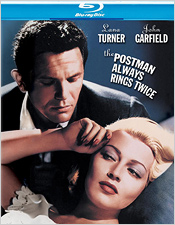Postman Always Rings Twice, The (1946) (Blu-ray Review)

Director
Tay GarnettRelease Date(s)
1946 (November 13, 2012)Studio(s)
MGM (Warner Home Video)- Film/Program Grade: A
- Video Grade: B+
- Audio Grade: B
- Extras Grade: B+
Review
Metro Goldwyn Mayer’s 1946 film of James M. Cain’s novel The Postman Always Rings Twice was actually the book’s third screen adaptation. Yet this first American movie version of the compelling tale of deceit is arguably the best-remembered. It deftly circumvented the strict production code of the era to become an all-time noir classic. The Postman has just made its Blu-ray debut courtesy Warner Home Video in a spiffy, if not overwhelming, edition.
The film’s story is a straightforward one. Nick Smith (Cecil Kellaway), owner of a California roadside gas station and diner, finds his life with attractive young wife Cora (Lana Turner) altered forever when Cora becomes involved with drifter Frank Chambers (John Garfield). Before long, Cora and Frank are plotting the older man’s demise, and through a series of twists and complications, leading to their own demises. (The Postman Always Rings Twice is, ironically, a rather moral film, based on the fates of its “protagonists.”) In many ways, it’s typical film noir. Director Tay Garnett’s film begins with a voiceover. Composer George Bassman’s bombastic music swells when, before long, Frank and Cora first lay eyes on one another and again when they illicitly kiss. But there are many touches that elevate the film.
Frank Chambers’ influence on the sleepy California burg of Twin Oaks is exerted subtly at first: the diner gets a new neon sign, for one. But Garnett allows us to physically see Chambers’ dominance over Cora Smith, even with Lana Turner epitomizing the femme fatale. Chambers looms uncomfortably close to her, and the camera makes his power clear. In her first major dramatic performance, insecurities crack through Turner’s chilly veneer. She calculatingly takes on a small “little girl” inflection as she implores Frank to take conclusive action against her husband: “Can’t you see how happy you and I would be here together, without him?” Then her tone, just as quickly, becomes breathy. Turner captures the impetuous, pouty, and alluring qualities of Cora. Harry Ruskin and Niven Busch’s screenplay has its share of surprises, especially as the kindly Nick’s own character unfolds. His repeated plays on the guitar of the 1929 standard “She’s Funny That Way” take on new significance. The screenplay and direction are sharp and taut as Frank and Cora perform a true dance of death throughout the picture.
The performances are uniformly strong. There’s just the right amount of complexity looming underneath the surface in John Garfield’s intense performance. Leon Ames takes glee in his role as fast-talking, crafty District Attorney Sackett who’s kept close tabs on the lovers’ plot, but he meets his match in an even craftier lawyer named Keats (Hume Cronyn). The future voice of Fred Flintstone, Alan Reed, has a small but pivotal role as a gumshoe.
Of course, from the actual scenes of violence to the depiction of Frank and Cora’s romance, much is left unseen. (The same certainly cannot be said of the steamy 1981 remake starring Jack Nicholson and Jessica Lange.) Waves frequently crash on the beach at dramatic moments, taking on numerous meanings. (In addition to the obvious use of the waves as a stand-in for the mounting sexual tension, might Frank and Cora have washed away their sins in the ocean’s water just prior to a fateful, final twist?) But the film holds up, and is at times shockingly relevant. It fleetingly comments on the nature of celebrity when Twin Oaks becomes a bustling destination following a sensational murder trial. Cora’s oft-stated desire “to be somebody” still, clearly, resonates in many troubled souls today.
Warner’s new 1080p BD presentation is finely detailed with natural grain. The video quality isn’t as eye-opening as some other films of similar vintage from the studio. But the blacks, grays and whites in this tense noir drama are well-rendered. Audio, a mono track in DTS-HD MA 1.0, is similarly good for both dialogue and music, though Bassman’s score isn’t one of the greats. (English SDH subtitles are also present.)
Special features are much stronger, though they have all been carried over from Warner’s 2004 DVD edition of the film. Best of all is a 2001 Turner Classic Movies documentary, Lana Turner: A Daughter’s Memoir. Turner’s daughter Cheryl Crane is featured in the roughly 90-minute film, narrated by Robert Wagner. Garfield, who died tragically young in 1952 at just 39, also gets an hour-long spotlight in The John Garfield Story, narrated by his own daughter Julie. An odd but delightful supplement is MGM’s 1943 short Red Hot Riding Hood, directed by the irrepressible Tex Avery. It inspired several other cartoons from Avery starring his exaggeratedly amorous wolf and remains one of the most beloved animated shorts of all time. Most fascinating might be the barely half-hour long radio broadcast from 1946 also starring Garfield and Turner; this truncated version of the film hits the high points but leaves little room to breathe! A 1945 Crime Does Not Pay short subject entitled Phantoms, Inc., the original theatrical trailer and an introduction by film historian Richard Jewell round out the bonuses here. There are no new special features, but only minor ones have been dropped from the ’04 DVD: a trailer for the Nicholson/Lange remake and a stills gallery.
The movie’s final moments explain the title of the film in no uncertain terms. Indeed, the postman always rings twice – and The Postman rings at least that many times. Yes, it’s likely this archetypical story will return again to the screen or to the stage, but it will be hard to top the smoldering yet restrained vision presented in this classic film adaptation.
- Joe Marchese

